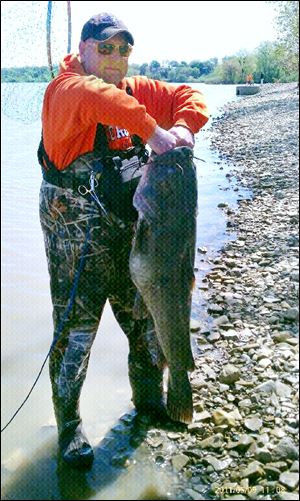
COMMENTARY
Behemoth flatheads a real handful
7/8/2011
Angler Dondi 'DJ' Sturm has to use two hands to hold up this 63-pound flathead catfish.
Traveling down the Maumee River by canoe from Fort Wayne last week, I wondered a couple of times how many fish we were paddling past -- including what I suspected were some good-sized flathead catfish.
These behemoths can go to 40 to 50 pounds, as most angling fans know. Then we stopped at day's end Thursday at Grand Rapids, beaching on the ramp at River Lures on the canal, where tackle manager Dondi "DJ" Sturm displayed a photograph of a river monster.
It was a flathead 46 inches long, weighing 63 pounds. "It's the biggest I've ever landed," Sturm said. And it's still swimming; Sturm safely released the fish after weighing and measuring.
Now the state record for flatheads, also known as shovelheads, is 76 1/2 pounds and 58⅝ inches (Clendening Lake, 1979). But even 63-pounders do not grow on trees, whether those trees are submerged in deep holes or not.
Speaking of deep holes, Sturm teased up this granddaddy from just such a deep just before high noon. "They will be where the baitfish are," he said. And in high sun, that means in the dark depths. Come dark, Sturm fishes the shallows, to which flatheads follow baitfish for their evening feasting. Fish that big eat a lot.
The man's favorite bait are commercially raised goldfish of six to eight inches length. That's right, goldfish. "They're bright, they're flashy, and they're very, very hardy," said Sturm. He hooks them just ahead of the tail so they can swim around, and has had them survive three days. He stores them live overnight in a minnow tank in the shop.
Sturm said he got hooked on flatheads five years ago, "ever since I moved here from the east side of the state. I hooked one, one day by accident and after a 20-minute struggle with him, I became addicted to catching them." That first flathead was 21 pounds, 31 inches.
The 63-pounder took considerably longer to land -- 45 minutes. "We got two good pictures of him and got him right back in the water. We rocked him back and forth to move water across his gills and he just took right off."
Landing such a big fish itself is a project. "When I got it close enough I saw the weight come out of the water, then I saw the top of the head and realized I had a big, big fish." A buddy nearby slipped a landing net over the big cat's mammoth head and Sturm slipped another net around its tail section. "We sandwiched it with nets and walked it to shore."
Sturm quickly removed the hook, broke out a digital scale, tape-measure, and camera for the necessities of recording the catch, and then tried to release the fish. Tried. But the cat would not let go.
"He bit down on my hands." His buddy finally had to wheedle the end of some needlenose pliers into the fish's mouth and expand the tool to pry open its mouth. Soon as Sturm's hands were free, the fish lit out for the depths like it was on fire.
Aside: Flathead catfish anglers can take notes on and follow the example of Sturm's conservation-minded ways in the careful handling and releasing of the big fish. It takes a long time to grow them to such proportions, and a lot of luck in the survival department. No one is going to eat such trophies; that is what small, plentiful channel cats and bullheads are for. So let's not waste them or treat them like so much garbage or garden fertilizer.
Sturm said he has been flyfishing since he was 5, and his late father, Elvin, taught him to catch and release trout. Even during the spring runs on the Maumee, he only keeps a couple walleye and later, a couple two-pound white bass, "which I like to eat."
He landed the big cat using a St. Croix seven-foot light-power, fast-action spinning rod. But normally he uses a Zebco Hawg Seeker rod of seven or eight feet in length. His reel of choice is an Okuma Trio 30 spooled up with 30-pound-test braided line, to which he ties a three-foot monofilament leader. Terminal tackle is a 5/0 red circle hook below a three-ounce pyramid weight. "It's got to be heavy enough so the goldfish won't swim away with your line."
Don't expect Sturm to give away his catfish honey holes. But he will admit that anywhere from Providence Dam down to Weirs Rapids is prime territory. He thinks the fish love the oxygen-enriched water that is well-tumbled and aerated on its trip through the rocks.
As if to show just what he means about the just-mentioned stretch of water, a young man came into River Lures last Saturday to weigh a 38-inch, 40-pound flathead that he caught while bass fishing near the Grand Rapids Bridge. He was using a glow nightcrawler, fishing for bass, and wound up with his hands full battling a bulldog of a flathead.
Glow nightcrawler, Sturm noted, are made by placing normal nightcrawlers in a bedding laced with a powdered die. It helps catch the bass's eye. And it works for big flatheads too.
Contact Steve Pollick at spollick@theblade.com or 419-724-6068